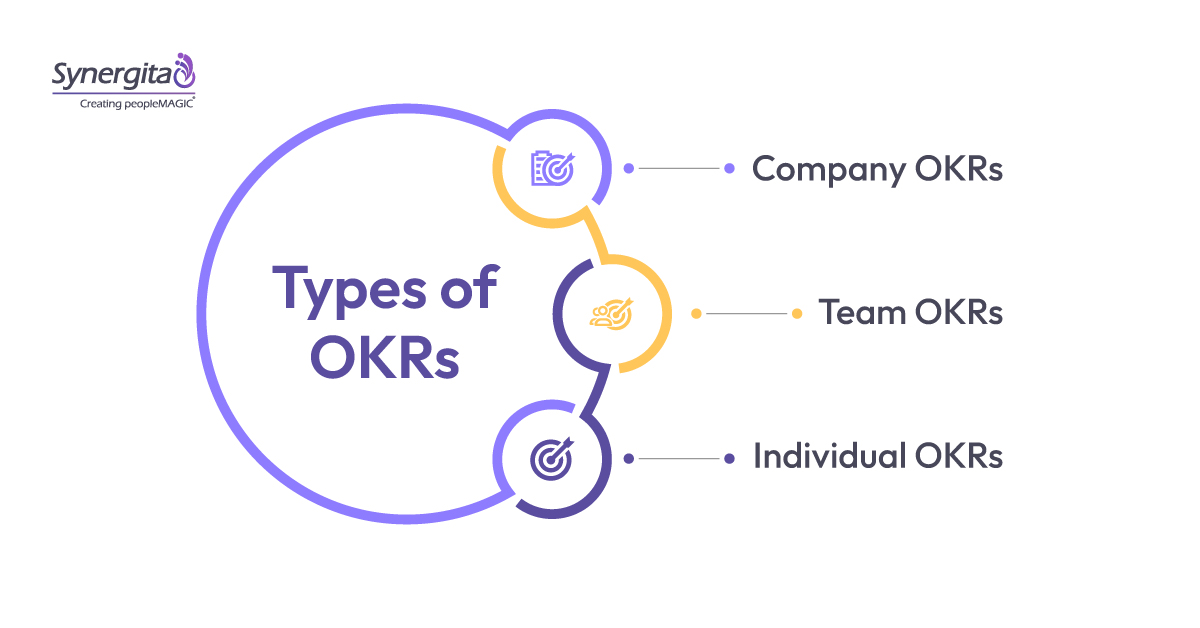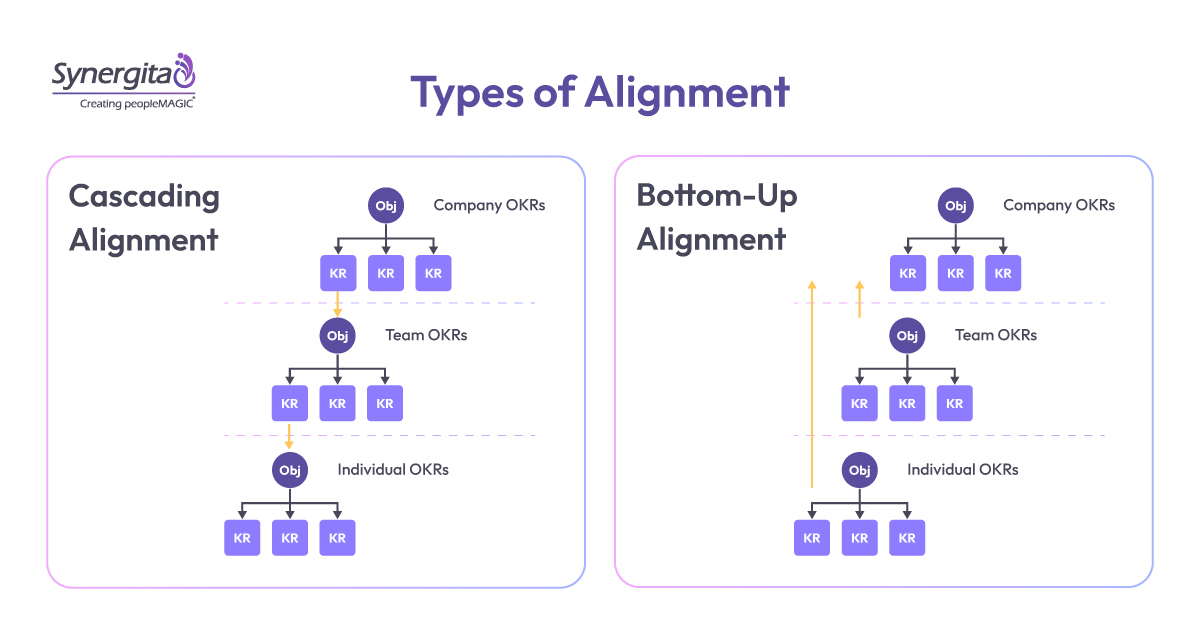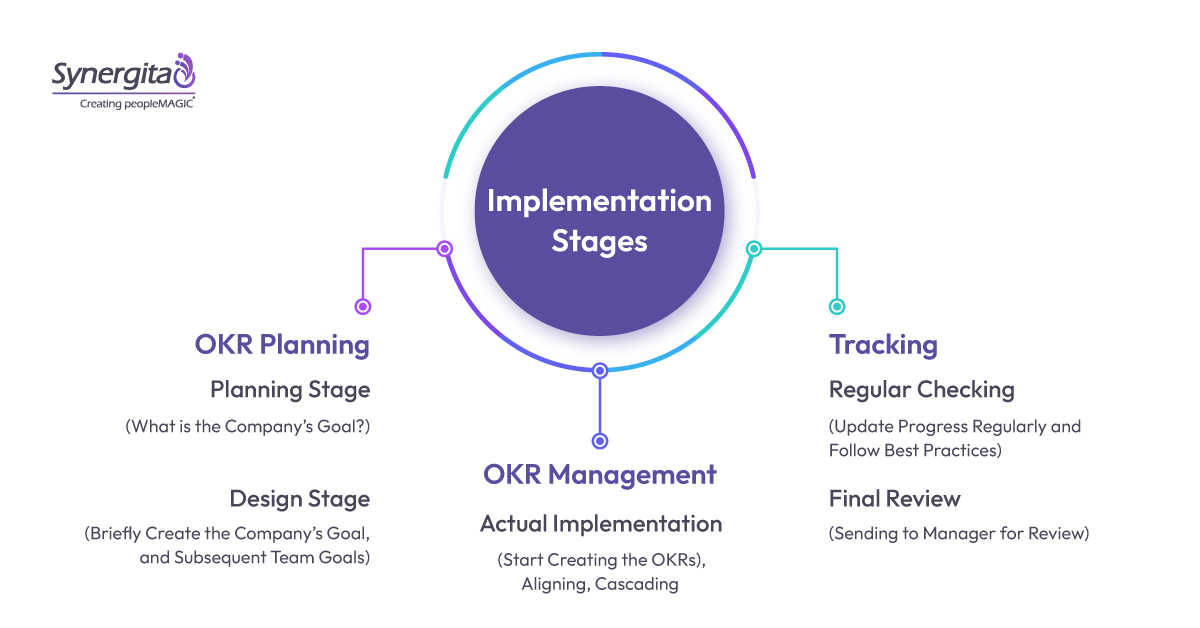
OKR Guide: Types, Benefits, Implementation & Best Practices
New to OKR? Here let us get you up to speed...

The acronym OKR, which stands for (OKR) Objectives and Key Results. The OKR methodology is a goal-setting framework that aids organizations in defining and tracking measurable goals. It empowers leaders to communicate what they want to accomplish with their internal or external teams so that the teams can align with their goals, and work in a way that prioritizes and contributes to those goals. When one tries to dissect the OKR framework it is easily understandable that it is a two-part framework: the initial part deals with the use of clear, ambitious goals, or Objectives, and the part two of the framework is the measurable and time-bound outcomes, called Key Results. While objectives help set up expectations and inform trajectory, the key results help to determine how the team or individual is progressing with those goals. In short, the OKR methodology is about creating alignment and engagement around measurable goals from the top down to the bottom up.
Objectives in OKR (Objectives and Key Results) are qualitative, aspirational, time-bound goals that answer the question, “What do we want to achieve?” Goals are the things that an organization/team wants to achieve. It ought to be ambitious, qualitative, and focus on larger strategic priorities. Objectives give direction and focus, motivating efforts toward meaningful purpose.
Key Results are the qualitative and quantitative markers that tell us the answer to the question, “How will we know we are successful in achieving our goal? Key Results are measures of success for Objectives. There are usually 3-5 Key Results per Objective, connected to results, instead of tasks. Key Results help keep teams aligned by providing measurable performance indicators, enabling teams to make data-driven course corrections along the way in order to effectively reach the Objective.
The primary purpose of OKRs is to align teams and individuals with organizational goals, improve focus, and drive measurable progress. By setting clear objectives and tracking key results, organizations can ensure that everyone is working toward the same priorities. They foster ambition by encouraging stretch goals while providing a framework to track progress and adapt as needed. By promoting clarity, alignment, and measurable outcomes, OKRs enhance performance, collaboration, and agility, enabling organizations to achieve meaningful results efficiently.
The OKR framework was invented and popularized by personalities at Intel in the 1970s. Later it got adopted by companies like Google, LinkedIn, and Amazon. OKRs were primarily used in the IT & tech sectors due to their fast-paced, innovation-driven environments. That is said, their effectiveness in driving alignment and measurable outcomes has led to widespread adoption across industries. Right now, industries including healthcare, finance, and retail are included in the list of benefactors of OKR along with IT & tech. The initial popularity was due to the transparency, and accountability it offered. Right now, simplicity, adaptability, and focus on measurable results have made it a cornerstone of modern strategic planning and execution.

Company OKRS are high-level objectives/strategic OKRs set by the leadership to define the organization’s strategic priorities. These usually come with outcome based lagging metrics as key results. The direction of company OKRs are top down in a way that it creates guidance for the entire organization. The duration of such OKRs is usually a year or even multiple years, and the impact can either be moonshot or roofshot. For example, a company OKR might focus on increasing market share or improving customer satisfaction.
Team OKRs are functional OKRs set by teams or departments of an organization. These functional OKRs align with company OKRs but are tailored to specific departments or teams. They usually have outcome based leading indicators as their key results. True to its name, these OKRs are functional, meaning they are bidirectional (top-down and bottom-up), making them easy to align with the company OKRs. The duration of team OKRs is a few quarters up to a year, and the impact they provide will be moonshot or roofstop. For instance, a marketing team’s OKR might focus on increasing lead generation by 30%.
Individual OKRs are a type of OKRs that fall under personal goals that align with team and company OKRs. They are great for combining performance management with OKR. They have the shortest span of any other OKRs and have a bottom-up approach to the team and company OKRs. An individual OKR might focus on improving a specific skill or completing a project.
For more insights on applying OKRs across company, team, and individual levels, check out our latest blog OKRs for All Reasons: Company, Team, and Individual

In this approach, OKRs are cascaded down whether it is company to teams or/and teams to individuals. A top-down alignment ensures organizational priorities. Company OKRs and Team OKRs can have top-down alignment, while individual OKRs cannot have it because it falls under the last line of an organizations structure.
In this approach, OKRs are aligned upwards, whether it is teams to company OKRs or individual OKRs to team and company OKRs. Bottom-up alignment is available in team OKR and individual OKR. The teams and individuals propose OKRs that align with company goals, fostering ownership and engagement.
Want to explore how OKR software can streamline goal alignment and tracking? Check out our blog Benefits of Having an OKR Software in Your Organization
The OKR framework is versatile and can be applied across industries. Especially the core feature of OKR which includes simplicity and flexibility makes it applicable to all domains. Industries starting right from tech startups to healthcare organizations can leverage OKR and enjoy its productivity benefits. Here are some more industries that has a growing trend of using OKR for business benefits:
Objective: Strengthen brand presence and engagement.
Objective: Improve sales performance and deal closure rate.
Objective: Foster employee engagement and retention.
Objective: Deliver faster, high-quality support experiences.
Objective: Accelerate product innovation and adoption.

The planning stage involves defining the company’s overarching goals and priorities. Leadership should identify 3-5 high-level objectives that align with the organization’s mission and vision.
Once company OKRs are set, teams and individuals create their own OKRs that align with these goals. This stage ensures that everyone understands how their work contributes to the organization’s success.
During implementation, teams and individuals begin working toward their OKRs. Regular check-ins and updates ensure alignment and progress.
Tracking involves monitoring progress toward Key Results and making adjustments as needed. Teams should update their OKRs weekly or bi-weekly to stay on track.
At the end of the OKR cycle, teams and individuals review their progress with managers. This review helps identify successes, challenges, and areas for improvement.
Looking for a detailed guide on effective OKR strategy? Check out our blog Goal Setting Using OKR: A Step-by-Step Guide for OKR Strategy 2025
Writing good OKRs starts with clarity. Objectives should be inspiring—something that excites your team. Key Results must be measurable, like "Increase customer satisfaction score from 80% to 90%." Avoid vague language—instead of "improve sales," say "grow revenue by 20%." Keep it simple: 3-5 Objectives, each with 2-4 Key Results. Make sure they’re ambitious but realistic. If they feel too easy, push further. And always align them with company goals—OKRs shouldn’t exist in isolation
One big mistake? Setting too many OKRs. Focus matters. Another is making Key Results vague—"increase productivity" isn’t measurable. Avoid setting OKRs in a top-down bubble; teams should have a say. Don’t treat OKRs like tasks—they’re outcomes, not to-do lists. And never ignore tracking—check progress regularly. Lastly, don’t punish failure. OKRs should stretch teams, and missing ambitious targets is okay if you learn from it.
Objective: Position our product as the industry’s top-rated choice.
Objective: Drive high-quality leads to fuel sales growth.

OKR software should make tracking easier, not harder. It should help teams see progress, align goals, and stay motivated. The best tools are intuitive—no complicated setups. They should show how goals connect across teams (who’s working on what). Flexibility matters—OKRs change, and software should adapt. And it should track more than just completion—confidence levels, progress trends, and roadblocks matter too.
If it’s confusing, people won’t use it. Look for clean dashboards, easy goal-setting, and quick updates. No training manuals needed—just log in and go. Features like one-click progress updates and reminders help. Mobile access is a plus. The simpler it is, the more likely teams will stick with it.
Seeing how goals connect keeps everyone on the same page. A good tool shows a hierarchy—company OKRs at the top, then department, then team. Color-coding, arrows, or tree views help. When someone updates a Key Result, you should see the ripple effect. No more guessing how your work fits into the bigger picture.
OKRs shouldn’t be rigid. Cascading (top-down) ensures company goals drive team goals. But bottom-up alignment is just as important—teams should suggest OKRs that support strategy. The best software lets both happen. No forcing mismatched goals—just flexible linking so everything stays connected.
Just tracking "50% done" isn’t enough. Confidence levels (green/yellow/red) show if a Key Result is at risk. Progress bars are great, but also look for trend lines—are we speeding up or slowing down? Comments and blockers should be visible too. The more ways to track, the better decisions you can make.
OKRs aren’t the only goal-setting method. But they’re different—more flexible, more ambitious, and more transparent. KPIs track performance, but OKRs drive change. Traditional goal management is often static—OKRs evolve. Performance management focuses on reviews—OKRs focus on progress. The best part? OKRs unite teams around shared ambitions, not just individual targets.
OKRs push for growth, not just maintenance. They’re public—no hiding behind private goals. They encourage big thinking ("10x growth") but stay measurable. And they’re adaptable—quarterly cycles mean you can pivot fast. Unlike rigid annual goals, OKRs keep teams agile and aligned.
KPIs measure health (e.g., "customer churn rate"). OKRs drive action (e.g., "reduce churn by 15%"). Traditional goal management is often vague—OKRs demand metrics. Performance management evaluates people—OKRs focus on outcomes. They work together but serve different purposes.
OKRs create focus. No more scattered priorities—just a few clear goals. They boost transparency—everyone sees what matters. They encourage ambition (no playing it safe). And they improve alignment—teams pull in the same direction. Whether scaling fast or staying agile, OKRs keep organizations moving forward.
In conclusion, the OKR framework is a powerful tool for organizations looking to improve goal alignment, focus, and performance. By following best practices and leveraging the right OKR software, organizations can unlock the full potential of this methodology. Whether you’re in IT, healthcare, or retail, OKRs can help you achieve your business goals and drive success.